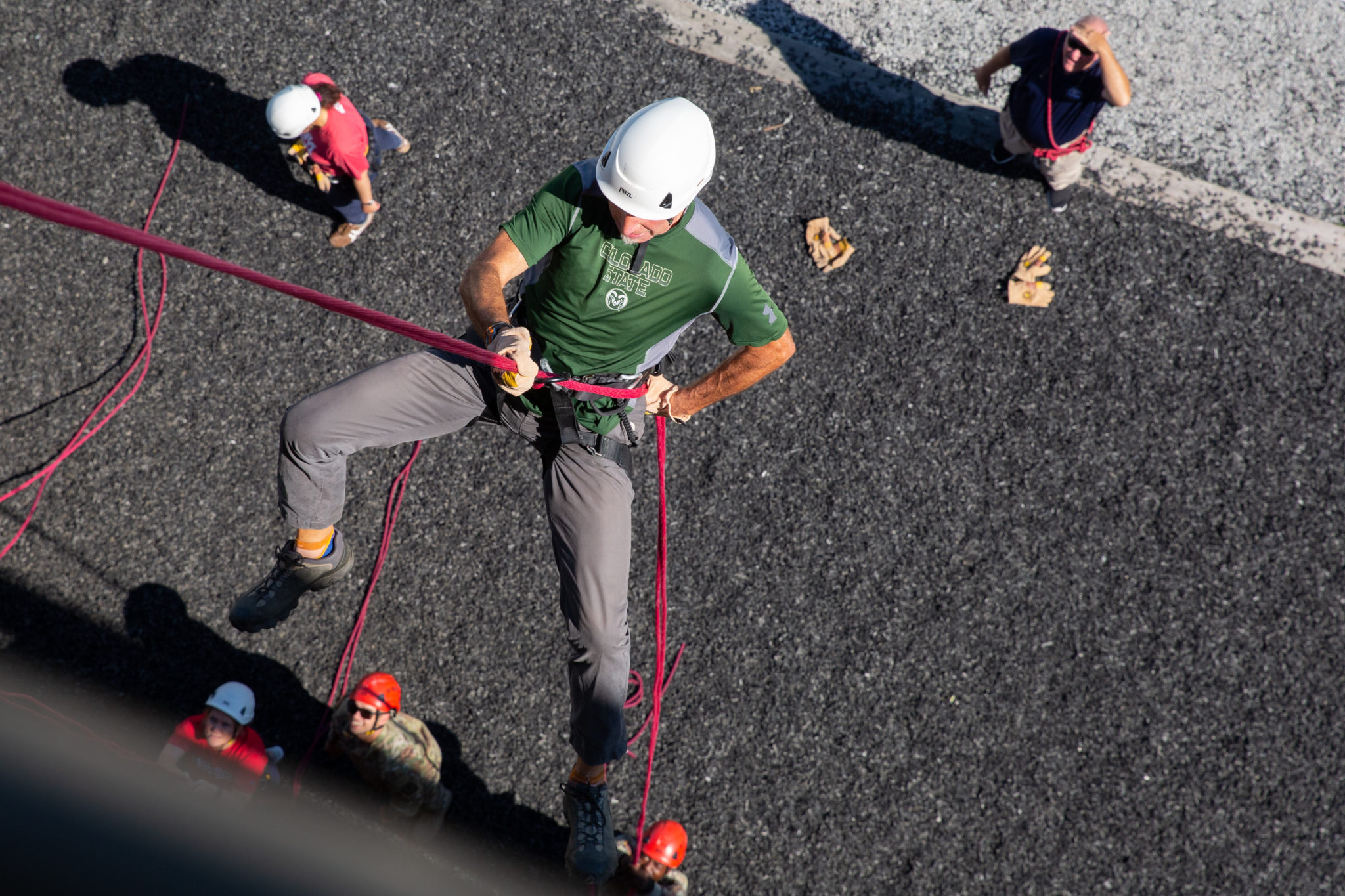
Barry Braun, health and exercise science professor and executive director of the Human Performance Clinical Research Lab, prepares to rappel off a 60-foot tower in Fort Knox, Kentucky.
Barry Braun has an interesting story to share when his students return for fall classes at Colorado State University. The health and exercise science professor and executive director of the Human Performance Clinical Research Lab rappelled off a 60-foot tower in Fort Knox, Kentucky.
It was all part of the Army ROTC Cadet Summer Training Leadership Symposium in June. Braun was one of a select few to participate in the symposium’s Center of Influence, in which more than 200 universities compete for representatives.
According to Al Armonda, an instructor in CSU’s Department of Military Science, the Center of Influence is an annual program that gives university leaders and faculty the opportunity to experience and learn more about the ROTC program as well as share knowledge. Participants experience many of the activities that hundreds of cadets participate in during the Summer Training Leadership Symposium.
“COI is for individuals who — by virtue of their relationship with and access to ROTC prospects — are capable of directly or indirectly influencing these potential prospects to seek more information about ROTC,” Armonda said. “Dr. Braun and CSU AROTC share similar goals: Maximize individual wellbeing through holistic health practices.”
Braun, Armonda and research associate Alissa Newman have played a key role in a pioneering CSU study to determine the best training regimen for the proposed new Army Combat Fitness Test. Braun said the study was on the radar of Fort Knox leadership, who made note of it during the COI welcome reception.
Valuable experiences


In addition to rappelling off a 60-foot tower, Bruan was prepared to skydive with the Golden Knights, but high winds canceled the experience.
Braun said COI opened his eyes to all of the responsibilities of Army ROTC cadets: the academics, the physical training and the leadership activities that they must perform.
“It’s equivalent to being a student athlete in terms of having to juggle academics, physical training and leadership labs,” he said. “It made me think that we can do a better job of supporting them.”
In addition to rappelling off a 60-foot tower, Braun was prepared to skydive with the U.S. Army parachute team, the Golden Knights. However, high winds prevented the experience.
Despite not making the jump, Braun said he gleaned some valuable insights to bring back to the Department of Health and Exercise Science.
“One of the things we always preach at HES is learning how to take a leadership role and how to be a great teammate,” he said. “I feel that we can do a better job at imbuing students with those critical skills. The Army has been building team and leadership skills for hundreds of years, and we can learn something from them.”
Lt. Col. Matthew Tillman, who leads the CSU Army ROTC program, and Armonda were also at Fort Knox, providing support and participating in the Cadet Summer Training – the U.S. Army’s largest annual training event where nearly 7,000 cadets from across the country are assessed on their leadership skills. This included 34 Ram Battalion cadets.

Lt. Col. Matthew Tillman, who leads the CSU Army ROTC program, with Braun at the Army ROTC Cadet Summer Training Leadership Symposium.
“It is awesome to see Dr. Braun recognized at such a high level for his support of our ROTC program,” Tillman said. “However, he really represents the great support from faculty, staff and students of our land-grant university for our cadets on a daily basis. Our cadets – these students – have taken an oath to defend our constitution and to know CSU has their back is truly impressive. Dr. Braun represents that support so well.”
In addition to the encouraging words, Braun said that Tillman and Armonda provided support in more ways than he initially knew at Fort Knox.
“Matt and Al just happened to turn up when I was rappelling,” he said. “I thought, ‘Isn’t that nice.’ I didn’t realize that Alissa Newman had said to them, ‘Please don’t let him die.’ I thought they were being supportive, but they were also watching out for me.”
The Department of Health and Exercise Science is part of CSU’s College of Health and Human Sciences.